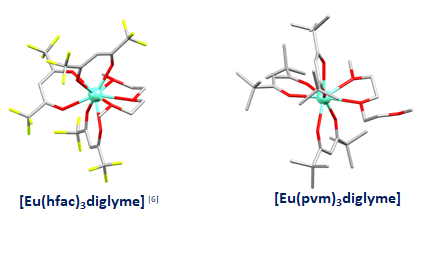(Re)investigating ternary rare-earth β-diketonates complexes: making new insights out of old ones
β-diketonates based rare-earth coordination complexes have enjoyed an expanding popularity ever since their discovery at the end of 19th century, which spans multiple applied research fields. Their multi-faceted chemical and physical properties have been successively harnessed for liquid extraction[1], bioanalytical imaging[2] as well as in light emitting devices[3]. Yet, the fast-paced development of rare-earth β-diketonates have at times been at the expense of in-depth solutions studies, undermining the trustworthiness of synthetic procedures as occasionally pointed out at in literature[4]. Within this context, our group dedicated efforts to describe the thermodynamic features of the association of [Ln(hfac)3(diglyme)] precursors with different (single or multi-sites) N-heterocyclic tridentate receptors, in solution[5]. The study was subsequently extended to a new series of [Ln(β-diketonates)3X] building-blocks (where X is a glyme), based on β-diketonates ligands displaying nuanced or contrasted electronic effects. A first part of the discussion will address the preparation of these new [Ln(β-diketonates)3X] precursors, before assessing their structural, thermodynamic and luminescent properties. Then, the propensity of these precursors to form stable ternary complexes with a N-heterocyclic tridentate ligand will be considered.

Figure 1. Crystallographic structures of selected [Ln(β-diketonates)3diglyme] containers.
[2] E.M. Surender, S. Comby, S. Martyn, B. Cavanagh, T. Clive Lee, D.F. Brougham, T. Gunnlaugsson, Chemical Communications, 2016, 52,1085–10861.
[3] A. de Bettencourt-Dias, Dalton Transactions, 2007, 0, 2229–2241.
[4] A) K. Binnemans, Handbook on the Photophysics and Chemistry of Rare Earths, Elsevier, Amsterdam, 2005, 35, Chapter 225. B) A.S. Chauvin, F. Gumy, I. Matsubayashi, Y. Hasegawa, J.C Bunzli, European Journal of Inorganic Chemistry, 2006, 473-480.
[5] A) K. Baudet, V. Kale, M. Mirzakhani, L. Babel, S. Naseri, C. Besnard, H. Nozary, C. Piguet, Inorganic Chemistry, 2020, 59, 62-75. B) L. Babel, K. Baudet, T. N. Y. Hoang, H. Nozary, C. Piguet, Chemistry A European Journal, 2018, 24, 5423-5443.
[6] W.J Evans, D.G Giarikos, M.A. Johnston, M.A. Greci, J.W. Ziller, 2002. Journa of the Chemical Society. Dalton Transactions, 2002, 520-526.